Air Purifier Prefilters: The Prefilter Experiments
Prefilters are designed to capture “large” particles – hair, insects, pollens – ahead of HEPA filters.
There are significant advantages to having multiple stages of filtration, with less efficient filters in series with fine particle grabbers.
The primary advantage of prefilters comes from extending the life of expensive HEPA filters and gas/odor cartridges by preventing dust coating and clogging.
HEPA filters are designed to trap small sub-micron particles and do not make good coarse dust collectors.
Think of the lint screen on the household clothes dryer – lint will bridge the HEPA filter’s pleats, preventing it from collecting fine particles.
But the problem with prefiltration is maintenance – pre-filters need to be changed or cleaned often.
In some cases recurring prefilter expense is a major cost factor.
Some less expensive polyester mesh carbon prefilters require replacement every 2-3 months to maintain minimal odor effectiveness.
With smoking, dust, or pets, these pre-filters can need monthly maintenance.
Mass market air cleaners from big-box retailers are often sold as loss-leaders for high margin replacement HEPA and HEPA-type filters.
Inadequate prefiltration is an easy way to insure a steady stream of filter orders.
Premium air purifiers generally have better, much longer lasting, pre-filtering.
IQAir makes the most advanced pre-filters. Their prefilter working alone, 55% efficient at .3 microns, offers better air filtering than the majority of air cleaners sold today do as a whole.
Austin Air pre-filters, while not in a league with IQAir’s, are cleverly designed to be vacuumed from the outside without disassembly, and last for a several years.
Efficiency Range
So “pre-filter” is applied to a wide range of products of varying effectiveness.
Few capture particles smaller than 1.0 micron in size.
Notable is RabbitAir MinusA2’s Pre-Electrostatic Filter which traps airborne particulate down to 1.0 micron.
The $1000 Sun-Pure Ultra prefilters particles larger than 5 microns.
Lesser air cleaners use a layer of woven polyester mesh or polyurethane foam, often coated with activated charcoal, which typically captures particles 15 microns and up.
This is furnace filter territory.
Typical disposable furnace filters for home use, with MERV ratings of 1 to 4, collect dust to 10 microns.
(Everyone who has not done so already should upgrade their HVAC system – furnace – filter to a minimum MERV 8 rated replacement.)
The carbon provides short term odor/chemical control, but makes the foam pre-filter un-washable.
I wouldn’t depend on this thin layer of carbon for chemical control – I have 5 pounds of carbon in my IQAir HealthPro Plus, and three more in my Sharp Plasmacluster.
I’d much rather have a prefilter that can be easily washed rather than replaced.
Some models, such as Sharps, Mitsubishis, and RabbitAirs, use fiberglass “lint screens” similar to those in clothes dryers – easy to clean, but may collect only 20 micron and above coarse dust.
Another twist to the lint screen is adding a Nano-Silver germicidal coating to protect the filters inside.
Availability
With the proliferation of makes and models and the air quality market shakedown, brands, models, and dealers are disappearing daily.
Most retailers no longer carry specialized prefilters for the planned-obsolescence big-box retail marketing models.
Good luck searching the web trying to find filters for discontinued mass-market machines.
Instead, universal pre-filter materials, which must be cut to size by the user, are becoming common.
So we are offered the opportunity to experiment with prefiltering materials on our own – what fun!
Carbon Wrap Prefilters – Generics and Substitution
As filter availability declines, many low cost internet filter outlets have begun to offer generic prefilter kits with sometimes misleading marketing.
Marketing might state “prefilters for Honeywell Hepa Fiters,” when the product is a generic without carbon.
Honeywell 38002 pre-filter kits, a best seller subject to many knock-offs, come in a red and white box, generics may ship in clear plastic wrap.
Honeywell’s polyester mesh has perforations for trimming to fit all the round Honeywells. Many generics omit the cutting guides, leaving frustrated buyers struggling to cut-to-fit.
While some generics work well, many users complain of problems with substituted products. Smells, ranging from faint chemical odors to rotting vegetation. are reported.
Granulated carbon that falls off, clogging the HEPA, is also a problem.
Thinner material and non-uniform thickness have also turned up in substituted wrap-style prefilters.
Buyers should watch for excessive shipping and handling charges back-ended onto bargain priced pre-filters.
But the main thing is to realize that a carbon-less generic foam substitute is worth $2, not $10.
See Honeywell 50250 experiment below.
The Prefilter Experiments
To save money, or because the prefilter is back ordered or discontinued, and out of sheer obstinacy, I make my own pre-filters.
Let’s try a few experiments with air purifiers waiting around my cabin, just yearning for more effective pre-filtration.
First we shop big box hardware aisles for appropriate pre-filter replacement materials.
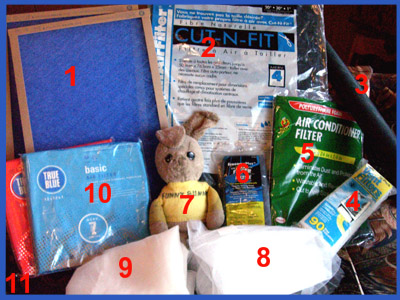
In the photo we have the results of a trip to Home Depot, Wal Mart, and Lowes:
- Fiberglass furnace filter MERV 2 (joke: would never use it) – 75 cents,
- Cut-N-Fit 1 inch thick Natural Fiber furnace filter MERV 4 – 20 by 30 inch block $5.46,
- Roll of fiberglass window screen, fine mesh, under $5 for lifetime supply.
- Self charging electrostatic AC Vent Filters, 12 pack – $2.96,
- Polyurethane foam AC filter 15 by 24 by 1/4 inch thick – $1.00,
- “Premium” AC filter 13.5 by 24 by 1/4 inch thick – $2.98,
- Dust magnet toy stuffed funny bunny, who insisted in being in the picture.
- Fine mesh nylon fabric, 2 yards – $1.67,
- Mesh polyester fabric, 2 yards – $2.06,
- “Basic” 12 inch square paper furnace filter, MERV 7 – $3.97
- “Allergen protection” 12 inch square paper furnace filter, MERV 11 – $7.97.
For under thirty bucks, a long term supply of prefilter materials, the prefilter “pile.”
All but the 12 by 12 paper filters, which are going in my $1,000 IQAirs, are washable.
Let’s build some prefiltering experiments.
IQAir Dust Pre-filter
My regular readers know I am a big fan of the IQAir air purifiers, rated highly here.
But IQAirs are expensive, and the class-leading IQAir prefilter cannot be vacuumed or washed.
IQAir offers an optional IQAir PF40 Coarse Dust Pre-Filtration Kit, for a whopping $139.00.
For those who are not mechanically inclined and have road dust, wildfire smoke, heavy pollen, or other large airborne particulate, the IQAir coarse dust kit, with its washable pad, will extend prefilter life.
But $140 is out of my price range.
So here is a low budget workaround.
IQAir has thoughtfully designed the bottom chamber of the HealthPro series air purifiers with roughly 12 inch square dimensions.
There just happens to be a furnace filter that same size that almost fits.
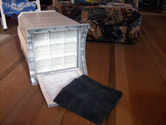

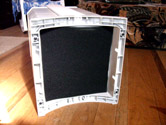
I lay my IQAir HealthPro Plus on its side – photo on left reveals prefilter in place, with the furnace filter, foam and screen.
Note we are not replacing the IQAir’s top-performing unit, but adding additional material where the coarse dust attachment would have fit.
In the middle pic, the MERV-11 furnace filter is fitted, with white vent filter foam stuffed in the gaps around the edges.
The third photo depicts a cut to fit square of 1/4 inch air conditioner polyurethane foam in place.
Not shown is the final layer of fiberglass window screen scotch-taped to the bottom.
The object here is to create a vacuumable and washable coarse dust apparatus for long term testing.
I am NOT worried that the increase in airflow restriction will burn up the motors in my quality IQAirs – they are designed to work under all conditions of loading.
On my second IQAir HealthPro, I’m using a MERV 4 for less restriction.
Update: Five years later the two Healthpros are still running perfectly with no replacement HEPAs.
Honeywell 38002 Replacement
Over the years, Honeywell has sold a boatload of 14 inch round filtered air cleaners.
The round Honeywells are a good value, now having vacuumable HEPA filters.
But Honeywell’s carbon impregnated 38002 universal cut to fit prefilter kit is a big seller at $10.
Yes, it isn’t expensive, but I have gotten tired of fighting with the velcro fasteners which hold it loosely. The gaps around the edge allow macro particles into the HEPA.
As mentioned above, I place little faith in the chemical control capabilities of this thin carbon layer.
I own three round Honeywells which would use the 38002 prefilter kit; 50250, 12520, and 12500. All still run after years of service, and numerous filter replacements.
So let’s try to drop the carbon and make an Austin Air style permanent vacuumable and washable prefilter to eliminate trips to the big box store for prefilter kits.
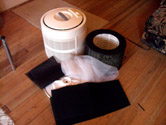

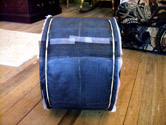
The first photo shows the disassembled Honeywell with replacement materials.
Second is two 24 inch sections of polyurethane foam AC filtering material, trimmed to fit and wrapped around the HEPA filter, secured by three big rubber bands.
Last, the white nylon mesh fabric protrudes from beneath fiberglass window screen, held by additional rubber bands.
Update 03/10/15: Five years later this 50250 is still running the modified prefilters, but the rubber bands were replaced by a hand sewn window screen wrap which secures the whole thing.
Update: Honeywell has gone to a three-piece modular filter setup which annoys many buyers, but this 14-year old (2001) 50250 still runs 24/7 with the original one piece HEPA, I just vacuum the exterior of the sewn fiberglass window screen every couple months.
The round Honeywells are easier to do with two people – four hands – but I use my knees and feet to hold the filter while wrapping.
I routinely hose out the round base, but not the motor housing, on the 50250.
The big ‘ol Honeywell has plenty of power to push this slight increase in restriction.
As time passes we’ll try to vacuum the beefed up prefilter as our only maintenance.
Holmes HAP-242 as a Dust Prefilter
Holmes HAP-242 is cheap air purifier sold as a loss leader for the HEPA-type and polyester mesh prefilters.
Many years ago, I paid $20 for the first little Holmes I bought, only to find replacement filters cost as much as the machine!
Over the years, the replacement filter to initial price ratio has improved, but many folks end up discarding these once the original filters are clogged.
I have collected four of these gadgets at garage sales and secondhand stores for a total investment of $32.
Like everybody else, I want a clean home without all the labor of constant vacuuming and dusting.
But an air purifier doesn’t take the place of cleaning and pollutant source removal.
Dust that you can see with the naked eye is large – 20 microns and up.
Also note, this project is intended to collect macro-particle dust, to complement other more sophisticated air purifiers, not as a stand alone device.
What we are trying to do is turn the little Holmes into a 10 micron pre-filter.
With lowered resistance, our dust collector is freer-flowing than the original HEPA-type installation, producing noticeably larger air volume than a new HAP-series machine.
No need to worry about burning up this installation, with its increased airflow. I have run the 4 modified Holmes dust collectors for around 10 machine-years without incident.
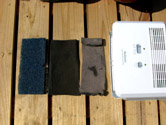


The left photo shows the disassembled Holmes, which has run for 5 weeks without cleaning, and the three layers of coarse particle filtration.
This experiment has a block of MERV 4 Cut-N-Fit 1 inch thick Natural Fiber furnace filter replacing the original loosely fitted HEPA-type filter.
Two layers of polyurethane foam are added, but many other materials can be used.
In the center, a closeup of the outer layer shows where my finger has dislodged a thick layer of dust accumulation.
Yucky dust that isn’t in an expensive filter I have to replace!
On the right, the reassembled unit.
Noticing that the natural fiber filter tends to shed a few shards, I am putting it in front of the foam filters this time.
I discard the ornamental plastic grille, allowing instantaneous visual evaluation of dust accumulation.
This little dust collector is taken outside and washed out completely with a garden hose every time the filters are cleaned.
These cheap air cleaners collect layers of dust on the inside, even with brand new HEPA-type filters.
This layer of dust on unprotected motors is a major cause of overheating and early failure in these made-in-China air cleaners.
So to prolong motor life and reduce fine particle emissions, I hose out the inexpensive Holmes. Draining carefully and waiting 24 hours until electrical parts are completely dry, I replace the cleaned filters and fire it up.
Note I would only wash the motor on a completely expendable machine, but these have run through dozens of washings.
Hunter 30748 Pre-Permalife Filter
Here is an experiment that failed.
Hunter Fan Company 30748 “Small Permalife Tower” was a short lived attempt to market the less-efficient-than-HEPA-standard “permalife” filter.
Intended to last indefinitely, this filter was designed to let most fine particles, which are the ones which eventually clog well built true-HEPA air filters, slip through.
Hunter Permalifes were mass marketed to naive buyers, as “99.5% effective,” while the truth was buried in the user manual – “as small as .5 microns from the air that passes through the filter.”
Real HEPA filters are “99,97 % efficient at capturing .3 micron particles,” and capture particulate to .1 micron.
But this sieve allows higher CADR ratings.
Permalifes got a boost from Consumer Reports, which ranked the Hunter Permalife 30547, a more powerful sister unit, third in a 2007 air cleaner rating article.
But it wasn’t long before the Permalife experiment faltered.
Hunter designed the Permalife series with seriously inadequate prefiltering.
The undersized carbon-polyester mesh is attached to the outer grill by small velcros, not secured to the main filter. Hunter left lots of space for large particles to slip past.
The result was predictable: the main filters clogged with large particles – lint, hair, and dead insect fragments – which supported the growth of mold and bacteria.
Unhappy customers demanded free replacements.
In only a few months the reserve inventory of “permanent” filters was gone.
Hunter was forced to redesign the product line as HEPA filtered machines, and discontinue the Permalifes.
Owners of Permalife models can buy HEPA replacement filters, but filter life will be short without better prefiltering.
So naturally Air-purifier-power had to grab one of the last Hunter Permalifes in the 50% off closeout sale at Lowes, and conduct an experiment to try to make the Permalife filter last.
This air cleaner is running in my rural Texas cabin.
Let’s select materials from the pile and build a proper prefilter.
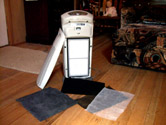

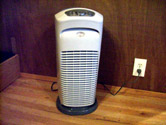
In photo one, I have stuffed the gaps around the main filter with black polyester mesh.
These gaps are intentionally left by engineers designing cheap mass market air cleaners to supply cooling air for the motor.
Next, I cut rectangles of plain polyester mesh furnace filter, fine mesh nylon fabric, and window screen, slightly larger than the Hunter’s loose fitting prefilter.
I lay the Hunter 30748 on its back and neatly stack all four layers, including the original equipment carbon prefilter, on top.
Snapping the cover closed traps the pile.
There is plenty of room for more than tripling the previous prefilter capacity.
By increasing air restriction we are risking burning up a low quality Chinese export.
So it is important to monitor the experiment for signs of motor overheating, checking for warmth and sniffing exhaust frequently.
For those trying this at home, I recommend running the air cleaner on middle speed, avoiding prolonged high speed operation.
Let’s see if the new prefilters can make the Permalife concept work.
Update: After five days running with the restrictions, the Hunter began emitting a burnt smell.
So scratch one experiment, not a surprise (Hunter Fan dropped out of the air purifier space soon after this post).
Who knew air purifiers could be so much fun?
I’ve been a ceaseless campaigner against dangerous products most of my adult life.
My detailed knowledge was gained the hard way: through a 40 year struggle against multiple chemical sensitivities (MCS), chronic fatigue (CFIDS) and Fibromyalgia.
Over my incredible life I provide air purifier review knowledge to many around the world. I was reccomending HEPA filters since 2005 and was the first to use Dylos DC1100 to test air purifiers for reviews.
—————————————————————
Ed passed away in the arms of his loving wife, on December 26, 2015, at their home in Elgin, Texas.
He lives on through his contributions to the web’s air quality section. Air Purifier Power is now managed by the team at HouseFresh, which was heavily inspired by his work in air purification.